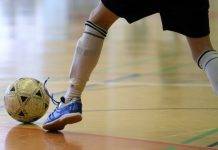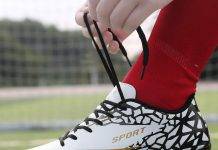In sports, finding the right equipment is crucial for success.
As high school football players, we often find ourselves in a predicament when choosing the appropriate footwear. Will soccer cleats, designed for a different sport altogether, be suitable for football?
This burning question has captured our curiosity, and in this article, we aim to explore whether soccer cleats can be utilized on the football field.
Let’s embark on this journey together as we delve into cross-sport footwear choices and uncover the truth behind the compatibility of soccer cleats in high school football.
Can You Play High School Football With Soccer Cleats?
As friendly sports enthusiasts, many of us enjoy participating in multiple sports. However, when it comes to proper footwear, it’s essential to understand the specific requirements of each game. If you’re a high school football player who also dabbles in soccer, you may wonder if it’s possible to wear your soccer cleats on the football field.
In this article, we will explore the pros and cons of using soccer cleats for high school football, compare them to football cleats, discuss the rules and regulations regarding footwear in high school football, address safety concerns, examine the performance impact, highlight the benefits of using football cleats, and provide tips for transitioning between the two.
By the end, you will have a comprehensive understanding of whether soccer cleats suit high school football.
Review contents
Pros of Using Soccer Cleats for High School Football
One advantage of using soccer cleats for high school football is their versatility. Soccer cleats are designed to provide excellent traction on various surfaces, including both natural grass and synthetic turf. Since many high school football fields utilize artificial turf, soccer cleats can provide the necessary grip and stability for quick cuts and lateral movements. Additionally, soccer cleats often have a lower profile, which can enhance the player’s connection to the ground, enabling greater control and agility on the field.
Another benefit of soccer cleats is their lightweight construction. Compared to football cleats, soccer cleats are usually lighter and more flexible. This can be advantageous for players who prefer a lighter feel on their feet, allowing for increased speed and maneuverability. Moreover, soccer cleats typically feature a narrower fit, providing a snug and more responsive sensation.
Cons of Using Soccer Cleats for High School Football
While soccer cleats offer some advantages, there are also drawbacks to consider when using them for high school football. One primary concern is the lack of ankle support. Football cleats, specifically designed for the physical demands of the sport, typically feature a higher cut that supports and protects the ankles during aggressive movements and collisions. On the other hand, soccer cleats typically have a lower-cut design, which can expose the ankles to potential injuries on the football field.
Another drawback of soccer cleats is their stud configuration. Football cleats have longer, detachable cleats, providing better traction on grass surfaces. In contrast, soccer cleats usually have shorter, fixed studs intended for soccer-specific movements like quick stops and direction changes. This stud configuration may not offer the same level of traction and stability required for the different movements and playstyle of football.
Comparison of Soccer Cleats and Football Cleats
To better understand the differences between soccer and football cleats, it’s essential to compare their key features. Football cleats typically have a higher cut, offering enhanced ankle support in a sport known for its physicality. Soccer cleats, however, are designed with a lower cut to prioritize mobility and precision on the soccer field.
Regarding traction, football cleats usually have longer, detachable cleats that can be tailored to the field conditions, providing optimal grip and stability. With their shorter and fixed studs, Soccer cleats prioritize quick movements and agility over traction on grass surfaces.
The construction and materials used in both types of cleats also differ. Football cleats are often more robust and durable, as they are built to withstand the demands of tackle football. Soccer cleats, being more lightweight and flexible, prioritize sensitivity and touch to optimize ball control and kicking accuracy.
Rules and Regulations Regarding Footwear in High School Football
Before deciding which cleats to wear for high school football, it’s crucial to review the rules and regulations the respective athletic associations set forth. Different associations may have specific guidelines regarding footwear, with safety being a primary concern. For example, the National Federation of State High School Associations (NFHS) provides rules prohibiting using certain types of footwear that may pose safety risks. It is important to consult these guidelines and comply with the regulations to ensure fair play and the safety of all participants.
Safety Concerns Associated with Using Soccer Cleats
Safety is paramount when participating in any sport; high school football is no exception. While soccer cleats may be suitable for some players, their lower-cut design and lack of ankle support can increase the risk of ankle injuries, especially during the physical nature of football. Football cleats, with their higher cut and specific design features, offer a higher level of ankle support and stability, reducing the likelihood of sprains and other related injuries.
Furthermore, the stud configuration on soccer cleats may not provide traction for high school football’s various movements and surfaces. The longer, detachable studs on football cleats are designed to dig into the ground during intense physical engagements and provide superior grip, reducing the likelihood of slips, falls, and potential injuries.
The Performance Impact of Soccer Cleats in High School Football
When considering the performance impact of soccer cleats in high school football, it’s essential to acknowledge the different demands of each sport. While soccer cleats excel in agility, precision, and ball control, football requires a combination of speed, power, and physicality. The performance impact of using soccer cleats on the football field will ultimately depend on the player’s individual style, position, and playstyle preferences.
Players who prioritize speed, quick cuts, and lateral movements may benefit from soccer cleats’ lightweight and flexible nature. However, for positions that require more physicality, such as linemen and linebackers, the lack of ankle support and traction offered by soccer cleats can hinder performance and increase the risk of injury. Players must assess their playstyle and position before deciding on footwear.
Benefits of Using Football Cleats in High School Football
When it comes to high school football, wearing proper football cleats can offer numerous benefits. Football cleats are specifically designed to meet the demands of the sport, providing optimal performance, protection, and safety. The higher cut of football cleats offers enhanced ankle support, reducing the risk of ankle injuries during the game’s physicality.
Football cleats are equipped with longer, detachable cleats that can be adjusted to the playing field conditions, ensuring superior traction and stability in various situations. The longer cleats can dig into the ground during tackles, cuts, and other explosive movements, minimizing slips and falls. Additionally, football cleats are typically sturdier and more durable, capable of withstanding the rigors of tackle football.
Factors to Consider Before Choosing Cleats for High School Football
Before deciding between soccer cleats and football cleats for high school football, there are several factors to consider:
- Position: Different positions have varying requirements regarding speed, agility, power, and physicality. Evaluate your playing style and position to determine which type of cleats would best suit your needs.
- Field Conditions: Consider the playing surface prevalent in your high school football program. Natural grass fields may require different traction compared to synthetic turf fields.
- Safety: Prioritize ankle support and stability to reduce the risk of injuries during physical engagements on the football field.
- Regulations: Consult the rules and regulations of your high school football association to ensure compliance with footwear guidelines.
Tips for Transitioning from Soccer Cleats to Football Cleats
If you are considering transitioning from soccer cleats to football cleats for high school football, here are some helpful tips:
- Ankle Support: Adjust to the higher cut of football cleats by gradually increasing wear time and practice sessions. This will allow your ankles to adapt and strengthen.
- Traction: Practice various football-specific movements on different surfaces to familiarize yourself with the grip and stability offered by football cleats.
- Comfort: Ensure proper fit by trying on different football cleat options and selecting a pair that provides the necessary comfort and support.
- Practice and Conditioning: Invest time in conditioning exercises specific to football to help your body adapt to the different physical demands of the sport.
Conclusion
In conclusion, while wearing soccer cleats for high school football may be tempting, there are essential factors to consider.
Soccer cleats have advantages in terms of versatility and lightweight construction, but they may lack the ankle support and traction required for the physical nature of football. Football cleats, specifically designed for the demands of the sport, offer enhanced ankle support, traction, and durability.
Ultimately, deciding to use either soccer or football cleats in high school football depends on individual preferences, position, and playing style. It is essential to prioritize safety, performance, and adherence to the rules and regulations set forth by the athletic associations.
By considering the pros and cons, comparing the features, and evaluating personal factors, you can decide which cleats are most suitable for your high school football experience.





































